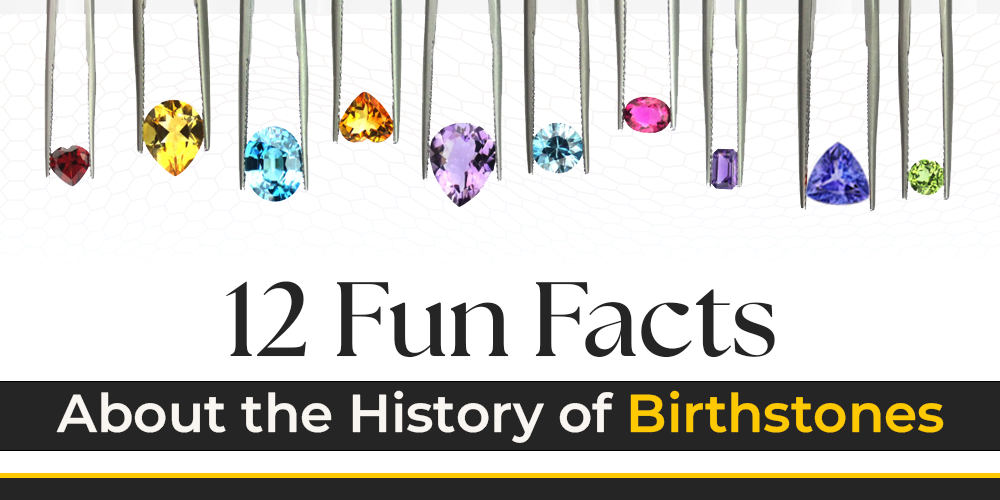Since ancient times, humanity has been captivated by the allure of precious stones. Their vibrant colors, dazzling sparkle, and inherent rarity have made them symbols of wealth, power, and beauty across civilizations. Among the many ways gemstones have woven themselves into our cultural tapestry, few are as personal and enduring as the tradition of birthstones. More than just pretty adornments, birthstones are thought to carry specific meanings, protect their wearers, and even bestow unique benefits, all tied to the month of one's birth.
At Bluestar Gemstones, we understand the profound connection people feel to these natural treasures. We meticulously source and offer an extensive collection of authentic, high-quality gemstones, perfect for celebrating life's most precious moments. From the deep blues of a Sapphire to the vibrant greens of an Emerald or the fiery reds of a Ruby, our selection allows you to explore the beauty and history embedded in each stone.
But where did this fascinating tradition come from? The concept of birthstones isn't merely a modern marketing invention; it's a rich tapestry woven through millennia of history, myth, and cultural evolution. Join us as we uncover 12 fun facts about the intriguing history of birthstones, inviting you to connect with the timeless legacy of these natural wonders.
Fact 1: Their Roots Lie in the Bible's Breastplate of Aaron
Perhaps one of the earliest and most significant references to a collection of twelve unique stones appears in the Bible, specifically in the Book of Exodus. This passage describes the Breastplate of Aaron, a sacred garment worn by the High Priest of the Israelites. This ceremonial piece was adorned with twelve different gemstones, each representing one of the twelve tribes of Israel. The stones mentioned included sardonyx, topaz, carbuncle (likely a garnet), emerald, sapphire, diamond, ligure (possibly zircon or jacinth), agate, amethyst, beryl (aquamarine or emerald variety), onyx, and jasper.
This ancient listing is widely considered the foundational inspiration for birthstone traditions. While the exact identification of all these stones is debated by modern gemologists due to differences in ancient terminology, the concept of linking specific stones to distinct entities (in this case, tribes) laid the groundwork for future associations with months and individuals. At Bluestar Gemstones, our commitment to offering authentic and natural stones echoes the timeless value placed on these original gems. Imagine holding a magnificent Blue Sapphire from our collection, connecting directly to a lineage of reverence that spans thousands of years. Or perhaps a vibrant Garnet, reminiscent of the ancient carbuncle, a stone of deep historical significance.
Fact 2: They Were Originally Worn for Their Astrological Power
Before their association with birth months became prominent, gemstones were primarily linked to the twelve signs of the Zodiac. Ancient cultures, deeply immersed in astrology, believed that wearing the stone corresponding to your astrological sign would amplify its celestial power and offer protection or good fortune. Each Zodiac sign was associated with one or more specific gemstones, thought to harness the cosmic energies unique to that period.
For example, Amethyst, a beautiful purple quartz, was often associated with Pisces or Aquarius, believed to bring clarity and protection. Peridot, with its distinctive olive-green hue, was linked to Leo, thought to bring good cheer and dispel fear. The idea was to collect all twelve stones and wear them at specific times of the year, particularly during their associated astrological period, to maximize their benefits. This practice emphasized the stone's inherent magical or protective qualities rather than its direct connection to one's birth month. Our diverse collection at Bluestar Gemstones allows you to explore stones tied to every Zodiac sign, such as a radiant Spinel for Leo or a serene Iolite for Sagittarius, inviting you to tap into these ancient astrological connections.
Fact 3: The Tradition of Owning All Twelve Was More Common Than Just One
In the early days of birthstone tradition, it wasn't about wearing your birthstone exclusively. Instead, the popular belief was that a person should own all twelve gemstones and wear the one corresponding to the current month. The idea was that each stone possessed specific powers that were amplified during its designated month. By rotating through the collection, an individual could receive the unique blessings and protections offered by each gem throughout the year.
This practice speaks to a deeper belief in the inherent energies of gemstones and a desire to harness their collective power. Imagine a person in medieval times carefully selecting their Emerald for May, then switching to a dazzling Ruby for July, and later a serene Sapphire for September. This continuous rotation ensured a holistic connection to the natural and spiritual benefits attributed to each stone. At Bluestar Gemstones, we offer a vast array of high-quality, loose gemstones that make building such a historically inspired collection not just possible but a truly rewarding endeavor. Our exquisite Aquamarine for March, or a brilliant Tanzanite for December, could be part of your personal, rotating treasury.
Fact 4: Poetic Lists Helped Popularize the Monthly Association
While the concept of specific stones for specific times existed, it was largely through popular poetic lists and almanacs in the 16th and 17th centuries that the idea of monthly birthstones began to solidify for the general populace. These charming verses assigned a particular gem to each month, often describing its perceived properties or color. These poems were easy to remember and share, playing a significant role in spreading the tradition beyond astrological circles to a wider audience.
These early lists weren't always consistent, and many variations existed across different regions and publications. However, they provided a framework that gradually became more recognized. The beauty of these poetic assignments lay in their simplicity and charm, making the concept of a birthstone accessible and personal. For instance, a verse might describe the Garnet for January as a stone of protection and trust, or the Diamond for April as a symbol of everlasting love. At Bluestar Gemstones, we appreciate the enduring charm of these traditions. Our collection of ethically sourced, natural gemstones, like a vibrant Topaz for November or a sparkling Zircon for December, continues this legacy of beauty and meaning.
Fact 5: Color Was Originally More Important Than the Specific Gem Type
In the nascent stages of birthstone development, the color associated with a month often held more significance than the specific gem. For example, any red stone might serve for a "red" month, and any green stone for a "green" month. This flexibility allowed people to choose more affordable or readily available gems that matched the desired hue. It was the symbolic power of the color—be it the warmth of red, the calm of blue, or the renewal of green—that was paramount.
This highlights a practical aspect of historical gemstone usage, where availability and cost played a role in adoption. Over time, as gem identification became more precise and trade routes expanded, specific gem types began to solidify for each month. However, the legacy of color symbolism persists. Think of the vibrant greens often associated with May (Emerald), or the blues for September (Sapphire). Bluestar Gemstones celebrates this spectrum of color. Whether you're drawn to the deep blue of our Iolite, the sunny yellow of our Sphene, or the rich pinks of our Tourmaline, our diverse range of natural gemstones allows you to embrace the beauty of color, just as our ancestors did.
Fact 6: The Modern List Was Standardized in 1912 by Jewelers of America
For centuries, birthstone lists varied widely, leading to confusion and inconsistency. Different cultures, regions, and even individual jewelers had their own preferred associations. Recognizing this need for clarity, the Jewelers of America (then called the National Association of Jewelers) officially standardized the list of birthstones in 1912. This pivotal moment created a widely accepted, unified set of birthstones that is largely still in use today across the United States.
This standardization was crucial for the commercial jewelry industry, providing a clear reference for consumers and retailers alike. It solidified popular choices like Amethyst for February, Aquamarine for March, Diamond for April, Emerald for May, Pearl (or more accurately, Moonstone and Alexandrite for June, as Pearl is organic) for June, Ruby for July, Peridot for August, Sapphire for September, Opal or Tourmaline for October, Topaz or Citrine for November, and Zircon or Turquoise for December. While slight variations and additions have occurred since, the 1912 list remains the bedrock of the modern birthstone tradition. At Bluestar Gemstones, we are proud to offer a comprehensive selection that aligns with this definitive list, ensuring you find the perfect, authentic gemstone to celebrate any birth month. Our Alexandrite, a rare color-changing gem, or a brilliant Moonstone, are perfect examples of the exquisite options available for June.
Fact 7: Some Months Have Multiple Birthstones Due to Historical Evolution
Even with the 1912 standardization, some months still have multiple designated birthstones. This often stems from historical reasons, changing preferences, or the desire to offer options across different price points. For example, October traditionally had Opal as its birthstone, but Tourmaline was later added, partly due to Opal's delicate nature and partly to provide a wider variety of colors and price ranges. Similarly, June has traditionally been associated with Pearl, but Moonstone and Alexandrite were later added as more durable and gem-like alternatives.
These dual or triple birthstone assignments reflect the ongoing evolution of gemstone traditions and the market's response to consumer desires. It provides greater choice and allows individuals to pick a stone that resonates most with them, whether for its color, durability, or perceived meaning. This flexibility ensures that everyone can find a birthstone that truly speaks to them. Bluestar Gemstones embraces this rich diversity. Our extensive collection includes a wide variety of Opal types, from fiery reds to serene blues, alongside stunning Tourmaline in myriad colors, ensuring October-born individuals have an exceptional choice. For June, explore our mesmerizing Moonstone or the captivating color-change phenomena of our Alexandrite gems.
Fact 8: Cultural Variations Still Exist Worldwide
While the 1912 American list is widely recognized, it's important to remember that birthstone traditions are not universally consistent. Different cultures and countries have their own historical associations and preferred gemstones for each month. For example, some traditional British lists include unique gems not found on the American list, or assign different stones to certain months. In certain Eastern traditions, gemstones might be linked to planets or specific days of the week rather than months.
These variations highlight the rich and diverse ways humanity has engaged with gemstones across the globe. They remind us that the allure of these natural wonders transcends geographical boundaries, even if the specific associations differ. While Bluestar Gemstones caters primarily to the US market's standardized lists, our global sourcing efforts bring you a diverse range of natural gems that are cherished worldwide. Our exquisite Chrysoprase, a vibrant green chalcedony, might be a lesser-known birthstone but holds significant cultural value in other parts of the world, much like our beautiful Spinel is a celebrated gemstone globally.
Fact 9: Ancient Beliefs Attributed Healing and Protective Powers
Long before the concept of birthstones solidified, various cultures believed that gemstones possessed mystical, healing, or protective powers. These beliefs were deeply integrated into daily life, with specific stones worn as amulets or talismans to ward off evil, promote health, or bring good fortune. For example, Amethyst was believed to prevent intoxication, while Emerald was thought to improve eyesight and reveal the truth. Rubies were often worn by warriors for courage and invincibility.
This deep-rooted belief in the inherent properties of stones forms a crucial part of their historical allure. People didn't just wear gems for beauty; they wore them for perceived benefits that could genuinely impact their lives. While modern science doesn't substantiate these magical claims, the historical and cultural significance endures. The idea that a birthstone could offer protection or good luck remains a powerful and comforting thought for many. Bluestar Gemstones offers only natural, authentic gemstones, allowing you to connect with the same elemental beauty and historical reverence that inspired these ancient beliefs. Our exquisite Garnet can be seen as a symbol of protection, just as it was in ancient times.
Fact 10: Birthstones Are Also Used to Celebrate Anniversaries
The tradition of associating specific gemstones with significant life events extends beyond birthdays. Many gemstones are also traditionally given as gifts for wedding anniversaries, with each year marking a different stone. This practice offers a beautiful way to symbolize the enduring strength and growing beauty of a relationship, with each gem representing a milestone.
For instance, the 1st anniversary is often celebrated with gold or a simple colored gemstone, while the 10th anniversary is marked by Diamond, symbolizing enduring love. The 15th anniversary often calls for Ruby, representing passionate love, and the 20th for Emerald, signifying loyalty and hope. These anniversary stones provide another layer of meaning and tradition for celebrating life's journey. Bluestar Gemstones offers an unparalleled selection of gemstones perfect for commemorating any anniversary. Whether it's a brilliant Diamond for a decade of love or a rich Ruby for fifteen years, our collection provides the perfect symbol of your enduring commitment. Explore our range of Topaz and Aquamarine for earlier anniversaries, or a magnificent Sapphire for a 45th celebration.
Fact 11: Tanzanite Was a Recent Addition to the Official List
While the 1912 list provided a stable foundation, it wasn't set in stone (pun intended!). The most recent addition to the official American birthstone list occurred in 2002, when Tanzanite was added as an alternative birthstone for December. This marked a significant moment, as it was the first time a new gemstone had been added to the list since 1952 (when Alexandrite was added).
The inclusion of Tanzanite, a relatively newly discovered gem (first found in 1967 in Tanzania, hence its name), reflects the evolving nature of the jewelry industry and consumer preferences. Its stunning blue-violet hue quickly captivated the world, and its unique optical properties made it highly desirable. Its official recognition as a birthstone highlights its rising prominence and enduring appeal. At Bluestar Gemstones, we are proud to offer exquisite Tanzanite specimens, allowing December-born individuals to embrace this vibrant, modern, and ethically significant gemstone. Our selection includes beautiful cuts that showcase Tanzanite's remarkable color.
Fact 12: The Practice of Birthstones Gained Momentum in the 18th Century
While the ancient origins are clear, the popular adoption of wearing your own specific birthstone, rather than rotating all twelve, began to gain significant traction in the 18th century, particularly in Poland. It was then that Jewish gem traders in Poland are credited with promoting the idea that each person should wear the gemstone corresponding to their birth month as a personal talisman.
This shift marked a transition from a collective, astrological practice to a more individualized and personal form of adornment. It aligned with the burgeoning Romantic era, where personal identity and sentimentality became more valued. By the 19th century, especially with Queen Victoria's widespread influence on fashion and gifting, birthstone jewelry became incredibly popular, solidifying its place as a cherished tradition that continues to this day. Bluestar Gemstones honors this tradition by providing a wide array of natural gemstones, from the regal Sapphire for September to the vibrant Peridot for August, allowing everyone to find a personal and meaningful connection to their birth month. Each stone in our collection, be it a dazzling Spinel or a luminous Moonstone, carries this rich history.
The history of birthstones is as multifaceted and captivating as the gems themselves. From their ancient biblical origins and astrological connections to their modern standardization and recent additions, these precious stones have continuously evolved in their significance and symbolism. They serve as a beautiful reminder of our connection to history, to the natural world, and to our own unique identities.
At Bluestar Gemstones, we believe that every gemstone tells a story. Whether you're searching for your own birthstone, a meaningful gift for a loved one, or simply a breathtaking addition to your collection, we invite you to explore our unparalleled selection of authentic, natural, and ethically sourced gemstones. Discover the perfect Amethyst, a brilliant Ruby, a serene Aquamarine, or any other exquisite gem that resonates with your spirit. Each purchase from Bluestar Gemstones is not just a transaction; it's an invitation to own a piece of Earth's timeless beauty and a part of a tradition that has enchanted humanity for millennia.




